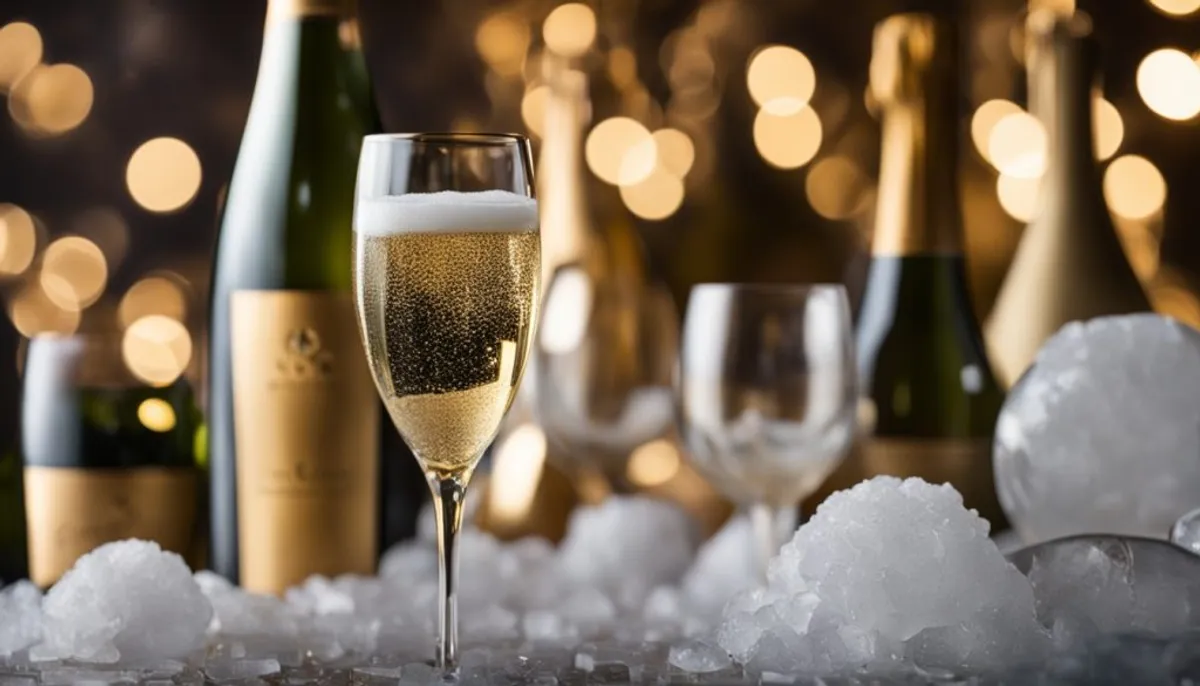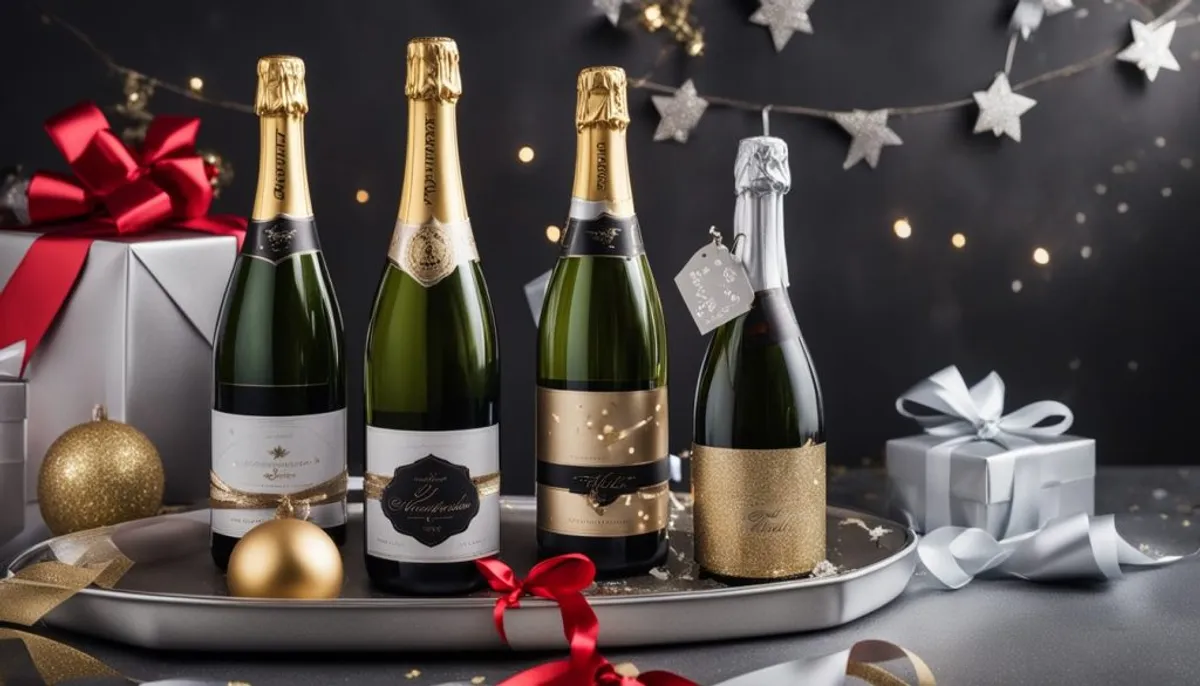Champagne is a sparkling wine from the Champagne region of France. It’s made with a method known as the “méthode champenoise” or “Champagne method.” This method includes a second fermentation in the bottle. Champagne is celebrated and enjoyed during special events and milestones.
This guide aims to lead you to premium champagne brands. It will also explain what to look for when choosing a champagne. You’ll get to know about different champagne styles, how to serve them, and great gifting ideas.
Key Takeaways
- Champagne is a sparkling wine that originates from the Champagne region of France.
- Champagne is produced using a specific method called the “Champagne method” or “méthode champenoise”.
- Champagne is considered a luxurious and celebratory drink, often associated with special occasions.
- This guide will explore the best champagne brands and factors to consider when selecting a good champagne.
- The guide will also provide insights into champagne styles, serving, and gifting options.
Understanding Champagne: A Luxurious Indulgence
Champagne is a sparkling wine made in a special way called the “Champagne method” or “méthode champenoise”. It gets its bubbles from a second fermentation in the bottle. This method is unique to the Champagne region of France. There, only wines made following certain rules can be called “champagne” thanks to the Appellation d’Origine Contrôlée (AOC).
What is Champagne?
The Champagne region sits northeast of France, about 90 miles from Paris. It has a special land and climate perfect for growing grapes for champagne. Here, they mostly use Chardonnay, Pinot Noir, and Pinot Meunier to make these fine bubbles.
The Champagne Region of France
The making of champagne takes a lot of work and time. Grapes are picked, pressed, and then the juice ferments to make still wine. Next, this wine is mixed and a second fermentation happens in the bottle for the bubbles. The wine is then left to age, often for many years, before it gets its final touches and is sealed.
The Champagne Production Process
Top Champagne Brands to Consider
Moët & Chandon is a top champagne brand founded in 1743. It’s known for top-notch quality and consistent taste. Their Moët Impérial and Moët Rosé Impérial are favorites. The brand symbolizes luxury and good times.
Veuve Clicquot is famous for its unique yellow label. Since 1772, it has offered the Brute Yellow Label. This champagne is loved for its balance and is often picked for big events.
Dom Pérignon is seen as very prestigious in the champagne world. It’s named after a monk who helped make champagne better. Only exceptional years see a Dom Pérignon. This champagne is known for its intricate taste and elegance, making it a luxury.
Choosing a good champagne
When picking a good champagne, think about the style and year it was made. Consider the brand’s reputation and what you like. Also, think about the event and the food you’ll have with it. Different champagnes go well with certain meals.
Champagne Tasting Notes
Exploring champagne tasting notes can be enlightening. Look for flavors like citrus, yeast, bread, and almonds. The champagne‘s feel in your mouth can be different too. It might be crisp or creamy, based on how it’s made.
Food Pairings for Champagne
Champagne goes with many foods. Pair brut champagne with oysters or sushi. Rosé champagne is great for desserts or grilled food. For seafood and light dishes, try blanc de blancs. They have hints of citrus and minerals.

Vintage Years and Their Significance
Champagne comes in two main types: vintage and non-vintage. Vintage champagne is made from grapes of a single good year. Non-vintage champagne mixes grapes from different years. The year a champagne is made greatly affects its taste. This depends on how well the grapes grew and the weather during that year.
Top picks for champagne include years like 2008, 2012, and 2002. These years bring out deep, rich flavors that get better with time. Other great choices are years like 1996 and 1988. These are favorites among people who love champagne and collect it.
Understanding Vintage Dating
Champagne from a single good year shows off that year’s unique qualities. Its label clearly shows the year it was made. This lets people know where the champagne is from and how well it might age.
Notable Vintage Years for Champagne
Some years stand out as really outstanding for champagne. For instance, in 2008, champagne was so good, Robert Parker rated it 99 out of 100 points. It was seen as the best year in the 21st century.
However, the 2001 champagne wasn’t as well-received. A very large harvest got hit by heavy rain at the last minute, making the champagne too watered down.
Other special years include 1996, which is considered the top year of the 1990s. The 1980s also had some great years. Like in the 1982, 1985, 1988, and 1989 vintages, Robert Parker gave them very high ratings. These scores showed how outstanding the champagne from those years was. Except for the 1982, which got a slightly lower but still amazing score of 94 points.
Champagne Styles and Varieties
Champagne is famous for its many styles and tastes. You might like the dry Brut Champagne or the pretty pink Rosé Champagne. There’s also Blanc de Blancs and Blanc de Noirs, made from different types of grapes.
Brut Champagne
Brut champagne is very popular. It’s known for being dry and not sweet. You can enjoy it alone or with many foods.
Rosé Champagne
Rosé champagne gets its color and taste from grape skins. It has a light pink color and subtle fruit flavors. It’s great for celebrations and goes well with seafood and desserts.
Blanc de Blancs and Blanc de Noirs
Blanc de Blancs comes from white Chardonnay grapes. It’s crisp and light. Blanc de Noirs comes from dark grapes. It has a richer, deeper taste.
Serving and Enjoying Champagne
To enjoy champagne fully, use the right glass. Champagne flutes are the best. They keep the bubbles and smell in. You can also use tulip glasses or ones for white wine.
Champagne should be cold, at 45°F to 50°F (7°C to 10°C). This keeps it fresh and brings out the different tastes and smells. If it’s too warm, the bubbles will go away fast and the flavor won’t be as nice.
Champagne Etiquette and Traditions
Some things about champagne to keep in mind are important. Always hold the glass by its stem to keep it cool. Look at the person you’re toasting. And, swirling the champagne a bit before sipping can make it smell and taste better.
Champagne Gifting and Celebrations
Selecting the Perfect Champagne Gift
Champagne is a top pick for all kinds of celebrations. Think birthdays, anniversaries, or even weddings. When choosing, look at what the person likes, the event, and what you can spend. You might go for a special vintage, a unique bottle, or a set with extra items like flutes.
Champagne for Special Occasions
Champagne shines at big moments like weddings and New Year’s. Its bubbles and festive feel are great for marking these times. No matter if it’s a common type or a special edition, champagne brings a bit of class and joy to the party.

Exploring Premium Champagne Houses
Exploring champagne means visiting top houses in the industry. These places are famous for their perfect champagne quality. They also provide special champagne experiences that you can’t find elsewhere.
Krug
Krug, founded in 1843, is one of the most respected Champagne houses. It’s known for its exceptional quality and for the Krug Grande Cuvée. This blend is praised as one of the best champagnes globally. They also make vintage champagnes, loved by collectors and experts.
Bollinger
Bollinger, starting in 1829, is iconic. It’s famous for its rich champagnes, mainly using Pinot Noir grapes. Their flagship Brut Special Cuvée shows Bollinger’s rich, fruity style with a spice hint.
Taittinger
Since 1734, Taittinger has crafted top-notch champagnes. It’s well-known for its Comtes de Champagne Blanc de Blancs. This champagne, made only from Chardonnay grapes, is celebrated for its elegance and balance.
Storing and Cellaring Champagne
Keeping champagne in the right place helps preserve its taste and quality, especially for special bottles. It’s important to store champagne in a cool, dark spot. The temperature should stay between 45°F and 55°F (7°C to 13°C).
Also, make sure the place is not too dry by keeping humidity from 60% to 80%. Store the bottles on their sides. This helps keep the corks from drying out.
Aging Potential of Champagne
Vintage or reserve champagnes can improve with age. These bottles sometimes get better over several years or even decades. Non-vintage champagnes, those without a year on the label, are best enjoyed sooner, within a few years.
The ability to age a champagne depends on the producer, the grapes used, and how it’s made. With the right conditions, some champagnes can keep well for 10 years or more.
Conclusion
Champagne is known for its elegance and joy in every pop. It has won over both wine lovers and those who just enjoy a good glass. By knowing what makes champagne special, the best brands, and how to serve and keep it, you can pick the right champagne for special occasions anytime.
Looking for something classic or affordable? Maybe a champagne that goes well with any dish? This guide helps you find what you’re looking for. From the top-notch Krug and Bollinger to the sophisticated Taittinger, you have many choices to explore.
Starting your champagne journey is about more than the taste. It’s a way to celebrate life’s moments. So, toast with your friends and family, and let champagne make your occasions truly special.
FAQ
What is champagne?
Champagne is a type of sparkling wine from the Champagne region of France. Its special making method is called “méthode champenoise.” This method means it undergoes a second fermentation in the bottle.
What are the main grape varieties used in champagne production?
The main grape types for champagne are Chardonnay, Pinot Noir, and Pinot Meunier.
What are some of the most well-known champagne brands?
Moët & Chandon, Veuve Clicquot, and Dom Pérignon stand out as some famous champagne names.
What factors should I consider when selecting a good champagne?
Think about the style, vintage year, producer’s fame, and your own taste. These factors help in picking the right champagne.
What are some common tasting notes for champagne?
Champagne often tastes of citrus like lemon, and grapefruit. You might also notice flavors of yeast, bread, and toasted almonds.
What are the differences between vintage and non-vintage champagne?
Vintage champagne is from grapes of a single year. Non-vintage is a mix from several years. The year has a big effect on its taste and quality.
What are the main styles of champagne?
Brut, Rosé, Blanc de Blancs, and Blanc de Noirs are the main styles. Each has a different taste and look.
What is the proper way to serve and enjoy champagne?
Serve champagne cold at 45°F to 50°F (7°C to 10°C). Use champagne flutes or tulip glasses for the best experience.
What are some popular champagne gifting options?
Vintage champagnes, special or limited-edition bottles, and gift sets are great options for gifting, especially when considering champagne for special occasions.
How should champagne be stored and cellared?
Store champagne in a cool, dark place at 45°F to 55°F (7°C to 13°C). Keep the humidity between 60% and 80% to maintain its quality.
RelatedRelated articles



